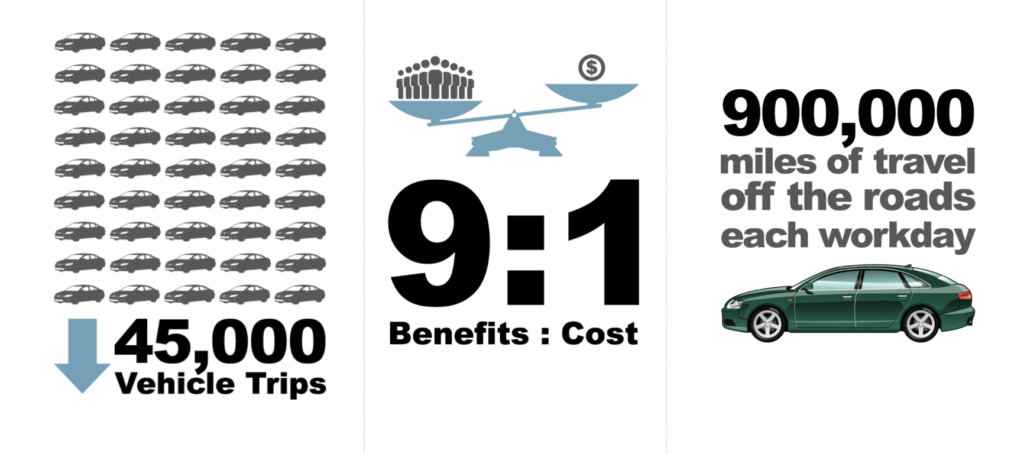Two easy ways to document your TDM program effectiveness
Transportation demand management (TDM) has long struggled with quantifying its results. Without the ability to measure outcomes from TDM strategies, policy makers, funders, planners, employers, real estate developers, and TDM practitioners cannot determine which strategies are most effective. They also can’t justify spending money on TDM programs and sustainable transportation.
That’s why we worked with university and government partners to build the Transportation Cost-Savings Calculator.
Arlington County Commuter Services, through its Mobility Lab, received a grant from the Federal Highway Administration and partnered with LDA Consulting and the Center for Urban Transportation Research (CUTR) at the University of South Florida to build upon proven evaluation methods and make them more readily usable by other jurisdictions nationwide. These tools can provide information to make more informed decisions on transportation policies, programs, and investments.
The TDM Return on Investment Calculator (TDM ROI), developed by LDA Consulting, builds upon earlier work in Arlington, the Washington D.C. region, and elsewhere to help users calculate vehicle trips and miles travelled reduced by their TDM programs and to calculate benefit-cost ratios or ROI. This spreadsheet-analysis method and a user manual for using it in your area may be downloaded here.
Similarly, the popular TRIMMS model 4.0 (Trip Reduction Impacts of Mobility Management Strategies) developed by CUTR has incorporated new background data on TDM strategies, making it now easier to perform analyses for your area. TRIMMS estimates the impacts of a broad range of TDM initiatives and provides program cost-effectiveness assessment, such as net program benefit and benefit-to-cost ratio analysis at an area-wide or site-specific level. It evaluates the impact of TDM programs based on default literature-based parameters for 99 metropolitan areas and constant‐elasticity demand functions and may be downloaded here.
Major TDM Benefits
The tools can be used to evaluate a specific worksite or area-wide programs. Among the TDM services that can be evaluated are:
- transit and other incentives
- carpool ridematching
- vanpooling
- parking policy
- bicycling and walking programs
- telework and compressed work schedules
- employer services
- marketing and promotion
- carsharing and bikesharing
- park-and-ride lots
- shuttle buses, and more.
Which tool is best for you?
Learn how to estimate the benefits of your TDM program with the TDM ROI Calculator or planned expansions of service with TRIMMS 4.0. These will be valuable additions to your evaluation methods.
Read the Project Overview Report for a brief explanation of what each tool does and for more information on the project, then download the methodology – or both – that will work best for your needs. For a deeper understanding of the TDM ROI Calculator, here is a webinar co-hosted by our research manager Dr. Lama Bou Mjahed.
Transportation Cost-Savings Calculators In Practice: Arlington
As an example of TDM impacts, the TDM ROI Calculator estimates that in the Arlington County, Virginia, area up to 45,000 vehicle trips and 900,000 miles of travel are taken off the roads each workday by drivers shifting from drive alone to other modes of travel. That results in approximately fourteen lane miles of road construction deferred. The savings to commuters, society, and government are up to $75,000,000 per year in congestion relief, road construction deferred, noise and air pollution avoided, fuel saved, crashes avoided. That means, for every $1 invested in Arlington’s TDM programs, the return on investment is up to $9.

Contact Us
The Mobility Lab team greatly appreciates your feedback.
If you would like to read our Express Newsletter featuring our latest TDM research and commentary sent directly to your inbox, click to Subscribe.
Mobility Lab
1501 Wilson Boulevard, Suite 1100
Arlington, Virginia 22209
703.228.6558